 I loved the fact that Simatai was not filled with tourists. The hike to the wall and up the wall was great. The sights are breathtaking and you fell inner peace. Might be for you who has come to Beijing surely know Badaling and Mutianyu Great Wall, two famous section of the Wall near Beijing. But, do you know Jinshanling Great Wall? Yes Jinshanling China Great Wall is located quite far from the capital but if you love hiking and adventurous then this section could be very ideal. This section has also known as the Wild Great Wall with its original features and untouched vegetation area in the surroundings. At past, Jinshanling to Simatai was quite popular hiking trail but since Simatai section has temporary closed because of renovation then this hiking route also temporary closed. Hike in Jinshanling within those 2 days were extremely hard and tired even more than our imagination. But, it was awesome and never disappointed. Before arrived in Jinshanling, our guide had already told us a lot of history and information about the Great Wall. The rest of the time in van till we arrived at Jinshanling we spent with relaxing and looking outside the window. Some friends of mine were also felt asleep. Better rest first for prepare your energy hike the Wall. For some tips Great Wall of China holidays, do not forget to bring your sunscreen, hat, water (lots of water) and bring your own toilet paper since there are no toilet papers in toilet of Jinshanling Great Wall. OK Jinshanling Great Wall id a real good place for you .when you are in Beijing and want to have a meanful holiday,No matter plan a Great Wall Hiking or Jinshanling Great Wall tour ! Great Wall of china tours choose Jinshanling !
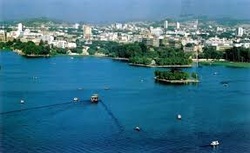 Jinan, the capital of Shandong Province, is located in the midwest of Shandong and acts as a traffic junction to many worthwhile attractions in the province. Known as the 'City of Springs', it is popular among visitors for its many springs and unique manly Lu Culture. Jinan is a historical city with a history of some 2,000 years and is famed for its numerous relics. It is the cradle of the Longshan Relics Culture, the reputed prehistoric culture of China and is found in Longshan Town, hence the name. Here you will find far more than you would expect, the ancient Great Wall of the Qi State (a state of the Zhou Dynasty (770B.C. – 221B.C.)), the colored sculptures of the Song Dynasty (960-1279) in the Lingyan Temple and so on. The city is the home of Shandong cuisine, a popular cuisine of China. The unique souvenirs include Ejiao, Black Pottery, Lu Embroidery and Wooden-Fish wares. Jinan is the right place to see some very typical festivals including The Lantern Festival in the Baotu Spring Park, the Lotus Festival in the Daming Lake Park and the Double-Nine Festival on the Thousand-Buddha Mountain. In the Daming Lake ParkThe city is hospitable and receives visitors from all over the world. Marco Polo once visited it and left words of praise to this city. The Baotu Spring, Daming Lake and the Thousand Buddha Mountain decorate the city as a beautiful garden. Compared with those capital cities, or other large and medium-size cities in China, the city has few advantages and lacks a metropolitan atmosphere, the highlight being its numerous springs. Some people say Jinan's glamour is not merely its enticing natural beauty, but more the warmth of the local people. The beauty of nature is thin and weak, but the beauty that comes from people will last forever.
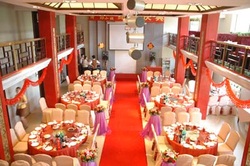 On June 6, 1996, the first Meizhou Dongpo Restaurant was established in Beijing with its signboard inscribed by Wang Guangying, vice chairman of the Standing Committee of the NPC. In 2003, the Beijing Meizhou Restaurant Management Co. Ltd. was established. Under the leadership of President Wang Gang, the employees devoted themselves to expanding the Dongpo culture and developing the brand, insisting on quality and innovation and guarding the strict quality. The enterprise developed quickly and became one of the most stable large dining enterprises in the domestic market. The dining enterprise now has: a head quarters, a distribution center, a central authority kitchen, over 20 chain restaurants and over three thousand employees in China. The company includes: Meizhou Dongpo Restaurant, Wangjiadu Chaffy Dish, Meizhou Snacks, Home-Made Specialty many other sections.
In 2000, the company was awarded an award as a "Sichuan Famous Restaurant" by the Sichuan Provincial Government. In 2002, they participated in the first Sichuan Cuisine Contest in the 12th National Chef Festival and were awarded the award of "Famous Banquet of China" and the "Team Gold Award". In the same year, the company was recognized as a "Chinese Famous Restaurant" by the China Cooking Association and President Wang Gang was given an award as a "China excellent Entrepreneur in Food and Beverage Industry". In 2003, President Wang Gang was granted an award of the "Standing Committee of the Meishan Committee of the Political Consultative Conference". That same year, Meizhou Dongpo was chosen as first in the Chinese Food and Beverage Industry by Tsinghua University School of Economics and Management. In 2005, President Wang Gang was awarded "The Excellent Carving" award and was engaged as an MBA assistant of Tsinghua University. In 2005, the company cooperated with the Hormel Company and produced Homel Meizhou Dongpo Sausage. In 2006, President Wang Gang was chosen as "The Greatest Power Person Of Beijing". In April of 2006, the company passed the standard for the ISO9000 Quality Management System. In 2007, President Wang Gang was chosen chairman on duty by FOODUN. Also in 2007, Meizhou Dongpo Restaurant was chosen as one of "Greatest Power Brands Top Ten" of Beijing and in April of 2007, the company was chosen as an advanced unit of Beijing Harmonious Labor Relations.
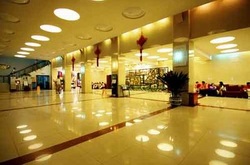 Chaoyang Theater on Dongsanhuan Road has a superior location and advanced management experiences, which enable it to be the best place for acrobatics performances. Its particular brand, Acrobatics World, has received wide recognition from many travel agencies both in and out of China. Some foreign travel agencies even make reservations two years in advance for the tickets of acrobatic performances held here. The most impressive characteristics of these acrobatics performances are beauty, thrill, surprise and inconceivability. So it is no wonder that Bora Milutinovic,the former head coach of Chinese National Football Team, Mr. Milutinovic, took his family to enjoy the acrobatics shows for four times and spoke highly of the performances by saying that "it's really marvelous here".
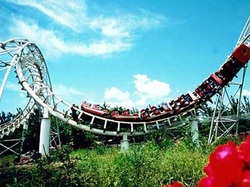 The Shijingshan Amusement Park is a State AAAA Tourist Area. It is located on the north side of the western end of Chang'an Avenue in Beijing and on the western side of the West Fifth Ring Road, 15 km from Tian'anmen Square. It is a scenic spot and theme park, integrating fitness, entertainment, appreciation of literature and art, catering and shopping. Completed in September 1986, the Shijingshan Amusement Park covers 340,000 square meters, is composed of three parts: the Entrance Zone Square, Eastern Science-fiction Theme Zone and the Western cartoon theme zone. The Entrance Zone Square is a sunken green culture square. The first level along the streets is a music fountain square, the second one contains a green lighting square covered with Chinese roses and flowers, and the third is used for cultural activity, covering 31,000 square meters. There are 71 various theme amusements. The track length of the suspended and reciprocating roller coaster totals 888 meters, ranking No. 1 in Asia; Jones Adventure heads the top in Asia for track height of 25 meters and total length of 480 meters. 4D Flying Theater boasts vertical a ball screen diameter of 22 meters; dynamic seat devices can raise the audience up to 15 meters in the air. The digital-controlled dynamics and restoration of digital camera shots enable the audience to simulate flying high in the sky.
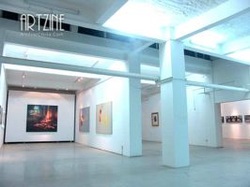 The 798 Art District is located in the Dashanzi area, Chaoyang District, in northeastern Beijing, past the 4th Ring Road. The large area was once a booming compound for the State's pre-reform electronic industries. After the economy toppled these dinosaurs the space became available and these former industrial units evolved into the now famous Factory 798.
798 stands for much more than a three digit number: in Beijing these numbers symbolize the country's cutting edge art movement led by the Chinese vanguard, unchained artistic personalities with alternative life goals. Wild and unconquered attitudes waft inside 798's free and rambling atmosphere. This area feels a kinship to what can be discovered and sensed along the Left Bank in Paris or around Greenwich Village in NYC.
The buildings were vital for China's old industrialization projects and they're just as key to the art scene at 798 as well. Constructed with help from the now former Soviet Union and designed by the former East German Republic, the architecture reveals and reminds visitors about the history of New China's industrialization, merging a free, creative spirit with the old, turgid Communist style.
As Beijing's economy developed after Deng Xiao Ping's reforms the structure of industry changed; the initial mission of the 798 District withered up and died. This industrial area quickly became desolate: businesses moved out, leaving empty factory shells behind. Like a graveyard the place was eerily quiet and dead.
Around 2002 an amazing reincarnation process began when artists' studios started cheerily popping up like daisies over graves. Today most of the properties are rented; new life and light has been created in these once hollow, unused buildings. Gradually the spaced has turned into a combination of swanky galleries, hip art centers & studios, pricey design companies & fashion stores, and cozy coffeehouses & bars.
798 has become the biggest arts area in China and earned great international acclaim in the space of just two years.
The 798 District impresses visitors by the odd but harmonious combination of historical and artistic factors... the formation of new, modern lifestyles in old spaces. Here art is alive and real, with artists at 798 living and working in spaces in tune with the past and the present.
The 798 Art District provides creative people with an opportunity and an outlet to enthusiastically pursue their artistic ideals. It has also given them a unique, spiritual homeland. China's artists have truly inspired new life into an area of Beijing, resurrecting the ghosts of the past while breathing in energy and innovation in the present. Indeed, China's vanguard has turned an industrial graveyard into an artistic paradise.
 The 798 Art District is located in the Dashanzi area, Chaoyang District, in northeastern Beijing, past the 4th Ring Road. The large area was once a booming compound for the State's pre-reform electronic industries. After the economy toppled these dinosaurs the space became available and these former industrial units evolved into the now famous Factory 798.
798 stands for much more than a three digit number: in Beijing these numbers symbolize the country's cutting edge art movement led by the Chinese vanguard, unchained artistic personalities with alternative life goals. Wild and unconquered attitudes waft inside 798's free and rambling atmosphere. This area feels a kinship to what can be discovered and sensed along the Left Bank in Paris or around Greenwich Village in NYC.
The buildings were vital for China's old industrialization projects and they're just as key to the art scene at 798 as well. Constructed with help from the now former Soviet Union and designed by the former East German Republic, the architecture reveals and reminds visitors about the history of New China's industrialization, merging a free, creative spirit with the old, turgid Communist style.
As Beijing's economy developed after Deng Xiao Ping's reforms the structure of industry changed; the initial mission of the 798 District withered up and died. This industrial area quickly became desolate: businesses moved out, leaving empty factory shells behind. Like a graveyard the place was eerily quiet and dead.
Around 2002 an amazing reincarnation process began when artists' studios started cheerily popping up like daisies over graves. Today most of the properties are rented; new life and light has been created in these once hollow, unused buildings. Gradually the spaced has turned into a combination of swanky galleries, hip art centers & studios, pricey design companies & fashion stores, and cozy coffeehouses & bars.
798 has become the biggest arts area in China and earned great international acclaim in the space of just two years.
The 798 District impresses visitors by the odd but harmonious combination of historical and artistic factors... the formation of new, modern lifestyles in old spaces. Here art is alive and real, with artists at 798 living and working in spaces in tune with the past and the present.
The 798 Art District provides creative people with an opportunity and an outlet to enthusiastically pursue their artistic ideals. It has also given them a unique, spiritual homeland. China's artists have truly inspired new life into an area of Beijing, resurrecting the ghosts of the past while breathing in energy and innovation in the present. Indeed, China's vanguard has turned an industrial graveyard into an artistic paradise.
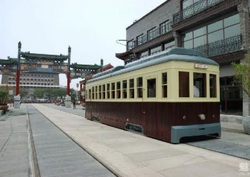 Qianmen Street is a well-known commercial street in Beijing. Located in the axis of Beijing, Qianmen Street goes from Zhengyangmen Embrasured Watchtower in the north and stretches to Tiantan (Temple of Heaven) Road in the south, which connects with Tianqiao South Street. Before the outer city was built in the 29th year of Jiajing (AD 1550) during the Ming Dynasty, Qianmen Street used to be the Royal Road for emperors to go towards the Temple of Heaven and Altar to the God of Agriculture. When the construction work of the outer city was completed, it became the main north-south artery in the outer city, called Qianmen Street by the people. This street was officially called Zhengyangmen Street during the Ming Dynasty, Qing Dynasty and the Republic of China, and was renamed as Qianmen Street in 1965. It is 1660 meters long and 20 meters wide (for carriageways).
With the urban development and building projects during the Ming and Qing dynasties, many bazaars and guild halls converged in Qianmen Street, which gradually made it evolve into a major business district focusing on shopping and entertainment. At the same time, Quanjude Peking Roast Duck-Since 1864, Bianyifang Roast Duck Restaurant, Ruifuxiang Silk-Since 1862, Tongrentang Chinese Medicine-Since 1669 and other brand shops also opened outlets here, and a century-old cultural circle has emerged as a result. In comparison with Wangfujing Pedestrian Street, Qianmen Pedestrian Street gives more prominence to the original flavor of Beijing. Qianmen Pedestrian Street consists of many functional areas such as Beijing's Culture, Domestic and Foreign Cuisines, Brand Shopping, Leisure & Fitness and so on. Nowadays, over 80 of China's Time-honored Brands along the street unfold the far-reaching cultural deposits and characteristics of historic heritages of the Qianmen Area.
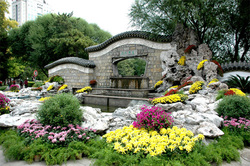 As one of the National AAA Tourism Attractions, Tuanjiehu City Park is modeled on a historic garden in South China, which covers an area of 123,000 m2, including a water area of 54,000 m2. The buildings in the park show not only the solemn of the North but also the features of the South, such as gray roofs, white walls and Nanmu color. The garden has a grassland of 36,970 m2 with 8,676 trees of various kinds, occupying 72% of the whole park. Thanks to the large variety of plants, the park remains green throughout the year.
The main attractions include Yunshan, Deyuelang, Shugehexiang, Mingyifang, Jingxiangting, Wanxiayixiuting, Liushuizhaobi, Lancuixuan and the Simulated Beach. The park is well designed with pavilions, corridors, towers, walls, bridges, boats and halls. The three bridges named “Huanbo”, “Jiexiu” and “Yinsheng”are beautifully and uniquely built. Minyifang, Deyuelang and Banbichanglang reveal the sense of traditional local architecture.
 Hefei Exhibition Park of the 9th China (Beijing) International Garden Expo (hereinafter referred to as "Tianjin Exhibition Garden") is located in the Modern Exhibition Garden, adjacent to Urumqi Exhibition Park and Tangshan Exhibition Park. Hefei Exhibition Park is full of green plants, and stream in the garden flows around Lotus Square, murmuring stream leading tourists to the depth of Garden for exploring its "secret".
Overall Bird`s Eye View
—Green Symphony, flourishing garden, garden city, beautiful homes--
"The endless drizzle wet spring mud, often hear water flowing and birds crowing separated by the fog. Willow hides a smile and peach is with smile, pass with a whip and see a boy is drawing at west of the bridge."
Hefei Exhibition Park opens with a poem-Spring Dawn of South Lake of Wang Tongwen from Qing Dynasty, "The endless drizzle wet spring mud, often hear water flowing and birds crowing separated by the fog. Willow hides a smile and peach is with smile, pass with a whip and see a boy is drawing at west of the bridge." It reflects honesty and integrity of Justice Bao with lotus with a sharp sense of integrity, and brings "Justice Bao spirit" of promoting honesty and upright to the world with the carrier "Justice Bao".
Exhibition Park adopts characteristics of Huizhou Architecture in Xidihong Village, and tourists can see archaizing memorial archway, Chaohu Lake, painting bridge, Justice Bao Culture Exhibition Area and Lianquan Scenic Spot, and Justice Bao Culture Exhibition Area forms a capital of "Combination" with Lotus Square, Justice Bao Sculpture and arced landscape pavilion, and shows welcome to friends from various regions by lotus- symbol and emissary of friendship.
|










 RSS Feed
RSS Feed